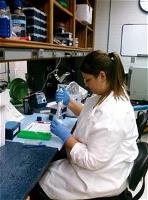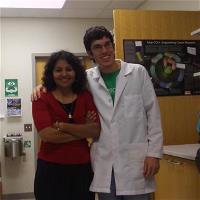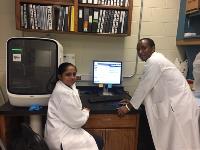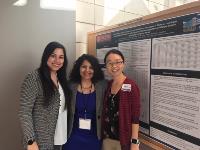 Dr. Dharambir Sanghera, PhD, FAHA is a Professor of Pediatrics, Physiology and Pharmaceutical Sciences and Dr. Geoffrey Altshuler Endowed Research Chair in Genetics. She is director of Genetic Epidemiology Laboratory at the University of Oklahoma Health Sciences Center (OUHSC). Dr. Sanghera’s health disparity research specializes in molecular and genetic epidemiological aspects of complex diseases, with special focus on Type 2 Diabetes, Obesity, Coronary Artery Disease, Stroke, and Dyslipidemia. She is Director and Principal Investigator of the Sikh Diabetes Study (SDS)/Asian Indian Diabetic Heart Study (AIDHS) and has over 21 years of experience for conducting large clinical genetic studies funded though NIH and Foundation grants. She is also principal investigator of the Metabolome in Ischemic Stroke Study (MISS) to identify biomarkers of Stroke in Oklahoma with Co-PI Dr. Evgeny Sidorov from the Department of Neurology at OUHSC.
Dr. Dharambir Sanghera, PhD, FAHA is a Professor of Pediatrics, Physiology and Pharmaceutical Sciences and Dr. Geoffrey Altshuler Endowed Research Chair in Genetics. She is director of Genetic Epidemiology Laboratory at the University of Oklahoma Health Sciences Center (OUHSC). Dr. Sanghera’s health disparity research specializes in molecular and genetic epidemiological aspects of complex diseases, with special focus on Type 2 Diabetes, Obesity, Coronary Artery Disease, Stroke, and Dyslipidemia. She is Director and Principal Investigator of the Sikh Diabetes Study (SDS)/Asian Indian Diabetic Heart Study (AIDHS) and has over 21 years of experience for conducting large clinical genetic studies funded though NIH and Foundation grants. She is also principal investigator of the Metabolome in Ischemic Stroke Study (MISS) to identify biomarkers of Stroke in Oklahoma with Co-PI Dr. Evgeny Sidorov from the Department of Neurology at OUHSC.
 Dr. Sanghera's laboratory is employing genome-wide linkage, genome-wide association and linkage disequilibrium approaches on family‐ and population‐based datasets, and is also examining the functional role of novel variants with insulin resistance, beta‐cell dysfunction and hyperlipidemia using zebrafish and cell model systems. The long‐term goals of Dr. Sanghera’s research are; 1) to identify the underlying molecular mechanisms associated with these disorders, 2) to improve the classification of the disease process by identifying genome‐wide patterns associated with ethnic variation, and 3) to discover new gene‐based targets based on ethnic origin and environmental and cultural differences which can inform the design of early prevention and treatment therapy among immigrant populations.
Dr. Sanghera's laboratory is employing genome-wide linkage, genome-wide association and linkage disequilibrium approaches on family‐ and population‐based datasets, and is also examining the functional role of novel variants with insulin resistance, beta‐cell dysfunction and hyperlipidemia using zebrafish and cell model systems. The long‐term goals of Dr. Sanghera’s research are; 1) to identify the underlying molecular mechanisms associated with these disorders, 2) to improve the classification of the disease process by identifying genome‐wide patterns associated with ethnic variation, and 3) to discover new gene‐based targets based on ethnic origin and environmental and cultural differences which can inform the design of early prevention and treatment therapy among immigrant populations.
Study Cohorts
Asian Indian Diabetic Heart Study/Sikh Diabetes Study (AIDHS/SDS)
 Through NIH support, we recruited ~5,300 SA participants as part of the AIDHS/SDS K01TW00608-02-05; K01TW00608-05-09 and R01DK0827660-08-15; PI Sanghera]. The AIDHS/SDS is designed to investigate the genetic and non-genetic factors underlie the unique non-obese metabolically obese phenotype of Punjabi Sikhs and South Asian Indians by using genome, metabolome and Omics technologies. Data generated by studies done by graduate students, clinical fellows and postdocs have resulted over 85 publications, and over 100 abstracts were presented at the local, regional, national and international meetings. The AIDHS/SDS has been currently supported by NIDDK R01 grant of over U.S. $ 2.5 million to identify new population specific metabolic risk factors in Asian Indians from Northern India.
Through NIH support, we recruited ~5,300 SA participants as part of the AIDHS/SDS K01TW00608-02-05; K01TW00608-05-09 and R01DK0827660-08-15; PI Sanghera]. The AIDHS/SDS is designed to investigate the genetic and non-genetic factors underlie the unique non-obese metabolically obese phenotype of Punjabi Sikhs and South Asian Indians by using genome, metabolome and Omics technologies. Data generated by studies done by graduate students, clinical fellows and postdocs have resulted over 85 publications, and over 100 abstracts were presented at the local, regional, national and international meetings. The AIDHS/SDS has been currently supported by NIDDK R01 grant of over U.S. $ 2.5 million to identify new population specific metabolic risk factors in Asian Indians from Northern India.
Metabolome in Ischemic Stroke Study (MISS)
 Acute ischemic stroke (AIS) is fourth leading cause of death and a major cause of serious disability in United States. According to the Department of Health statistics, in 2010, the state of Oklahoma had the 4th highest death rate due to stroke. Despite recent advances in technology, early diagnosis of AIS is still challenging. The MISS has been supported by the funding from Presbyterian Health Foundation of Oklahoma (Sanghera and Sidorov PIs). MISS is a prospective study which aimed to investigate the early biomarker predictors AIS by utilizing global metabolomics technologies using UPLC-MS/MS (Triple-TOF, ESI) and using serum and urine specimens collected at patients and controls using blood samples collected at acute stage and 2-3 month follow-up.
Acute ischemic stroke (AIS) is fourth leading cause of death and a major cause of serious disability in United States. According to the Department of Health statistics, in 2010, the state of Oklahoma had the 4th highest death rate due to stroke. Despite recent advances in technology, early diagnosis of AIS is still challenging. The MISS has been supported by the funding from Presbyterian Health Foundation of Oklahoma (Sanghera and Sidorov PIs). MISS is a prospective study which aimed to investigate the early biomarker predictors AIS by utilizing global metabolomics technologies using UPLC-MS/MS (Triple-TOF, ESI) and using serum and urine specimens collected at patients and controls using blood samples collected at acute stage and 2-3 month follow-up.
Predictors of Familial Combined Hyperlipidemia in Type 2 Diabetes (PRECISION MED) Study
The PRECISION MED study was started in 2019 with a goal to identify genetic and non-genetic factors responsible for familial or polygenic hyperlipidemia/dyslipidemia. The other goal is to identify high risk patients that poorly respond to lipid lowering therapies.
Key Findings of Our Laboratory
South Asian T2D GWAS and Identification of Novel Genes of T2D and Other Complex Diseases
 The data generated from our NIH-funded GWAS (R01DK 082766 Sanghera PI) and follow-up ancillary studies brought us amongst the world leaders in South Asian (SA) T2D/CVD genetics. Upon completion of the T2D GWAS and joint meta-analysis involving 27 studies including 128,127 individuals from multiple ethnic groups, we found a novel population-specific locus in association with T2D at 13q12 in the SGCG gene in the Sikh population from North India where the lead variant was monomorphic in Europeans and Africans. My group has also contributed to meta-analysis studies conducted by SAT2D, GLGC, CARDIOGRAM+C4D, DIAGRAM, GIANT, SAHTN, iGEN-BP, ISGC, and RoHGen consortia for global discoveries of variants associated with T2D, heart disease, blood lipids, obesity, stroke and other complex phenotypes.
The data generated from our NIH-funded GWAS (R01DK 082766 Sanghera PI) and follow-up ancillary studies brought us amongst the world leaders in South Asian (SA) T2D/CVD genetics. Upon completion of the T2D GWAS and joint meta-analysis involving 27 studies including 128,127 individuals from multiple ethnic groups, we found a novel population-specific locus in association with T2D at 13q12 in the SGCG gene in the Sikh population from North India where the lead variant was monomorphic in Europeans and Africans. My group has also contributed to meta-analysis studies conducted by SAT2D, GLGC, CARDIOGRAM+C4D, DIAGRAM, GIANT, SAHTN, iGEN-BP, ISGC, and RoHGen consortia for global discoveries of variants associated with T2D, heart disease, blood lipids, obesity, stroke and other complex phenotypes.
•Saxena RS, Been LF, Gravito ML, Braun T, Bjonnes A, Young R, Ho W, Maeda S, Cho YS, Tai E, Kelly M, Chambers J, Kooner JS,…. Kadowaki T, Deloukas P, Rader D, Danesh J, and Sanghera DK (2013). Genome-wide association study identifies novel loci contributing to type 2 diabetes in individuals of Punjabi origin from Southeast Asia. Diabetes. EPub doi: 10.2337/db12-1077. [PMID: 23300278] (Published with accompanied commentary)
GWAS of Leukocyte Telomere Length in Sikhs and Discovery of a Novel Locus
 Telomere length has been postulated as a biomarker of senescence and human aging in many published studies. Inter-individual variation in telomere length at birth and subsequent years is attributed to both genetic and environmental factors that start in utero. The cumulative impact of differential exposures to oxidative stress and other environmental stressors on telomere attrition in different ethnic groups have been shown to be predictors of cellular and biological aging that may impact race and ethnicity-related health outcomes. Our group led a global telomere length consortium to perform GWAS and meta-analysis studies to identify genes associated with telomere length and their associated impact on T2D and CVD. Our GWAS identified a novel signal within the Casein Kinase II (CSNK2A2) to be associated with telomere length using data from 16,998 individuals from four additional GWAS cohorts of European descent. CSNK2A2 phosphorylates TRF1 which initiates and regulates its binding to telomere. This was the first GWAS study on relative telomere length reported in South Indians.
Telomere length has been postulated as a biomarker of senescence and human aging in many published studies. Inter-individual variation in telomere length at birth and subsequent years is attributed to both genetic and environmental factors that start in utero. The cumulative impact of differential exposures to oxidative stress and other environmental stressors on telomere attrition in different ethnic groups have been shown to be predictors of cellular and biological aging that may impact race and ethnicity-related health outcomes. Our group led a global telomere length consortium to perform GWAS and meta-analysis studies to identify genes associated with telomere length and their associated impact on T2D and CVD. Our GWAS identified a novel signal within the Casein Kinase II (CSNK2A2) to be associated with telomere length using data from 16,998 individuals from four additional GWAS cohorts of European descent. CSNK2A2 phosphorylates TRF1 which initiates and regulates its binding to telomere. This was the first GWAS study on relative telomere length reported in South Indians.
•Saxena R, Bjonnes A,…KW, Maubaret CG, [………], Marvin P, Ralhan S, Wander GS, Mehra NK, Salpea KD, Gu J, Wu X, ManginoM, Hunter DJ, De Vivo I, Humphries SE, Samani NJ, Spector TD, Savage SA, and Sanghera DK (2014). A genome-wide association study identifies variants in Casein Kinase II (CSNK2A2) to be associated with leukocyte telomere length in a Punjabi Sikh diabetic cohort. Circulation Cardiovascular Genetics. 7: 287-295. [PMID: 24795349].
GWAS Study Identifies a Novel Locus Associated with Vitamin D Deficiency in Indian Sikhs
We recently conducted a comprehensive GWAS and replication studies and have identified a novel locus near FOXA2 associated with 25(OH)D concentrations (p=4.47x10-9). Additionally, our study also replicated 3 of 5 previously reported loci with 25(OH)D concentrations in European and Hispanic GWA studies. Thus far, no GWAS has been conducted for circulating vitamin D concentration in populations from South East Asia.
•Sapkota BR, Hopkins R, Bjonnes A, Ralhan S, Wander GS, Mehra NK, Singh JR, Blackett P, Saxena R, Sanghera DK (2016). Genome wide association study of 25(OH) Vitamin D concentrations in Punjabi Sikh: Results from the Asian Indian diabetic heart study. Journal of Steroid Biochemistry and Molecular Biology doi:10.1016/j.jsbmb.2015.12.014. [PMID:26704534]
Publications (2015-Present)
(Underlined names are of Students/Postdocs)
Sapkota, BR and Sanghera DK (2019). A rare missense variant in the milk fat globule-EGF factor 8 (MFGE8) increases T2DM susceptibility and cardiovascular disease risk with population-specific effects Acta Diabetologica: (in press).
Sidorov E, Beaver BM, Bejar C, Chao X, Ray B, Indukuri, VV, Reddivari L, Chainakul J, Vanamala JKP, Sanghera DK. (2019). Comparison of Metabolomic Profile in Acute and Chronic Stage of Ischemc Stroke. J of Stroke (in press).
Clark DW, Okada Y, Moore KHS, …Sapkota BR, Mason D, Pirastu N, I Gandin,….Sanghera DK, .Wilson, JF (2019) Associations of autozygosity with a broad range of human phenotypes. Nature communications 10 (1), 1-17
Sanghera DK, Hopkins R, Malone-Perez M, Bejar C, Tan C, Mussa H, Whitby P, Fowler B, Rao, CV, Fung KA, Lightfoot S, Frazer JK (2019) Targeted sequencing of candidate genes of dyslipidemia in Punjabi Sikhs: Population-specific rare variants in GCKR promote ectopic fat deposition. PloS One 14 (8), e0211661. PMID: 31369557
Sanghera DK, Bejar C, Sharma S, Gupta R, Blackett PR, Obesity Genetics and Cardiometabolic Health: Potential for Risk Prediction. Diabetes Obes Metab. 2019 Jan 22. doi: 10.1111/dom.13641. [Epub ahead of print] Review. PMID: 30667137
Larsson SC, Traylor M, Burgess S, Boncoraglio GB, Jern C, Michaëlsson K, Markus HS; MEGASTROKE project of the International Stroke Genetics Consortium. Serum magnesium and calcium levels in relation to ischemic stroke: Mendelian randomization study.Neurology. 2019 Feb 26;92(9):e944-e950. PMID: 30804065
Sidorov E, Sanghera DK, Vanamala, JKP (2019) Biomarker for Ischemic Stroke Using Metabolome: a Clinician Perspective Journal of Stroke 21 (1), 31-41 PMID:30732441
Adlam D, Olson TM, …CARDIoGRAMPlusC4D Study Group, Olin JW, Gulati R, Tweet MS, Hayes SN, Samani NJ, Graham RM, Motreff P, Bouatia-Naji N (2018). Association of the PHACTR1/EDN1 Genetic Locus With Spontaneous Coronary Artery Dissection. J Am Coll Cardiol. 8;73(1):58-66. doi: 10.1016/j.jacc.2018.09.085.PMID: 30621952
Franceschini N, Giambartolomei C, Sapkota B, MEGASTROKE Consortium, Dehghan A, Seldenrijk A, Morrison AC, S, Sanghera DK, Humphries SE, Völker U, Gudnason V, Hingorani AD, Björkegren JLM, Casas JP, O'Donnell CJ.(2018) GWAS and colocalization analyses implicate carotid intima-media thickness and carotid plaque loci in cardiovascular outcomes. Nature Communications. 3;9(1):5141. doi: 10.1038/s41467-018-07340-5. PMID: 30510157
Sanghera DK, Hopkins R, Malon-Parez MW, Bejar C, Tan C, Mussa H, Whitby P, Rao CV, Fung KA, Lightfoot S, Frazer JK, (2019). Targeted sequencing of candidate genes of dyslipidemia in Punjabi Sikhs: Population-specific rare variants in GCKR promote ectopic fat deposition. BioRxiv doi: https://doi.org/10.1101/526350
Sanghera DK, Bejar C, Sapkota B, Wander GS, Ralhan S (2018) Frequencies of poor metabolizer alleles of 12 pharmacogenomic actionable genes in Punjabi Sikhs of Indian Origin. Scientific Reports: DOI 10.1038/s41598-018-33981-z. PMID: 30356105
Malik, R, Chauhan, G, Sapkota B, .Sanghera DK, .MEGASTROKE Consortium:Multi-ancestry genome-wide association study of 520,000 subjects identifies 32 loci associated with stroke and stroke subtypes.(2018) Nature Genetics 50:524-537. PMID: 29531354
Hong J, Hatchell K, Bradfield, J P, Bjonnes A, Chesi A, Sapkota, B, … Hakanarson H, Harris, Tamara B, Kestenbaum, Bryan R, Kritchevsky, Stephen B.20; Loos, Ruth JF, Psaty, Bruce M, Sanghera, DK, Florez JC, Wang T; Liu CT, Engelman, CD, Billings, LK. (2018) Trans-ethnic Evaluation Identifies 1 Novel Low Frequency Loci Associated with 25-Hydroxyvitamin D Concentrations. The Journal of Clinical Endocrinology and Metabolism. 103 (4):1380-1390. PMID: 29325163
Reddivari L, Sapkota B, Rudraraju A, Yundi L, Sidorov E, Vanamala JKP, Sanghera DK. (2017) Metabolite signatures of diabetes and cardiovascular disease: a pilot investigation. Metabolomics, 13 (12), 154. (doi: 10.1007/s11306-017-1278-8) [PMID/N/A]
Zhao W, Rasheed A, Tikkanen E, Lee J, Sapkota B, ………Butterworth AS, Howson J, Assimes T, Chowdhuri R, Melander M, Damrauer S, Small A, Asma S, Imamura M, Liang KW, Anand S, Sanghera DK, Ripatti S, Loos RJF, Kooner JS, Tai ES, Rotter JI, Chen Y, Frossard P, Maeda S, Kadowaki T, Reilly M, Pare G, Melander M, Salomaa V, Rader DJ, Danesh J, Voight B, Saleheen D (2017). Seventeen novel loci associated with type 2 diabetes and shared etiological pathways with coronary heart disease. Nature Genetics, 49 (10), 1450. PMID: 28869590
Sanghera DK, Sapkota BR, Aston CE, Blackett PR (2017). Gender Differences in Vitamin D Status of Asian Indians with Type 2 Diabetes and Cardiovascular Disease Risk. (2017). Annals of Nutrition and Metabolism. 70 (2), 79-87. PMID:28315864
Loley C, Alver M, Assime T, Goel A, Gustafsson S, …….Metspalu A, Muredach, Reilly P, Ripatti S, Sanghera DK, Thiery J, Watkins H, Deloukas, P, Kathiresan S, Samani, NJ, Schunkert H, Erdmann J, König IR. (2016). No association of coronary artery disease with X chromosomal variants in comprehensive international meta-analysis. Scientific Reports: 6:35278 | DOI: 10.1038/srep35278. PMID: 27731410
Scott WR, Zhang W, Loh M, Tan ST, Lehne B, Afzal U, Peralta JM, Saxena R, Ralhan S, Wander GS, Bozaoglu K, Sanghera DK, Elliott P, Scott J, Chambers JC, Kooner JS (2016). Investigation of genetic variation underlying central obesity amongst Indian Asians. PLoS One: 11(5):e0155478. doi: 10.1371/journal.pone.0155478. PMID:27195708
Sanghera, DK (2016). Emerging epidemic of non-communicable diseases (NCDs) in South Asia: Opportunities for prevention. Journal of Diabetes & Metabolism: 7(2):647. doi:10.4172/2155-6156.1000647
Zanoni P, Khetarpal SA, … Abecasis G, Chowdhury R, Erdmann J, Nordestgaard BG, ……, Butterworth AS, Howson JM, Peloso GM, Stitziel NO, Danesh J, Kathiresan S, Rader DJ; CHD Exome+ Consortium; CARDIoGRAM Exome Consortium; Global Lipids Genetics Consortium. (2016) Rare variant in scavenger receptor BI raises HDL cholesterol and increases risk of coronary heart disease. Science. 351(6278):1166-71. PMID: 26965621
Imamura M, Takahashi A, Yamauchi T, Hara K, Yasuda K, Grarup N, Zhao W, Wang X, Huerta-Chagoya A, Hu C, Moon S, Long J, Kwak SH, Rasheed A, Saxena R, Ma RC, Okada Y, Iwata M, Hosoe J, Shojima N, Iwasaki M, Fujita H, Suzuki K, Danesh J,Jørgensen T, Jørgensen ME, Witte DR, Brandslund I, ……, Singh JR, Tam CH, Hirose H, Maegawa H, Ito C, Kaku K, Watada H, Tanaka Y, Tobe K, Kawamori R, Kubo M, Cho YS, Chan JC, Sanghera DK, Frossard P, Park KS, Shu XO, Kim BJ, Florez JC, Tusié-Luna T, Jia W, Tai ES, Pedersen O, Saleheen D, Maeda S, Kadowaki T (2015). Genome-wide association studies in the Japanese population identify seven novel loci for type 2 diabetes. Nature Communication. 28;7: 10531. doi: 10.1038/ncomms10531 PMID: 26818947
Sapkota BR, Hopkins R, Bjonnes A, Ralhan S, Wander GS, Mehra NK, Singh JR, Blackett P, Saxena R, Sanghera DK (2015). Genomewide association study of 25(OH) Vitamin D concentrations in Punjabi Sikh: Results from the Asian Indian diabetic heart study. Journal of Steroid Biochemistry and Molecular Biology doi:10.1016/j.jsbmb.2015.12.014. Epub 2015.[PMID 26704534 ]
Joshi PK, Esko T, Mattsson H, EklundN, Gandin I, Jackson AU, Nutile T, Schurmann C, PolasekO, Wilson JF, ROHgen consortium (2015). Runs of homozygosity reveal inbreeding depression on cognitive function and stature. Nature 523(7561):459-62. doi: 10.1038/nature14618. Epub 2015 [PMID:26131930]
CARDIoGRAMplusC4D Consortium (2015). A comprehensive 1000 Genomes-based genome-wide association meta-analysis of coronary artery disease. Nature Genetics. Sep 7. doi: 10.1038/ng.3396. [Epub ahead of print] [PMID: 26343387]
Sapkota BR, Subramanian A, Finley H, Blackett P, Aston CE, Sanghera DK (2015). APOE4 genotype carriers predict enhanced glycemic response and improved cardiovascular outcomes with metformin and metformin-sulfonylurea combination therapy: results from the AIDHS/SDS. Journal of Diabetes and its Complications. doi: 10.1016/j.jdiacomp.2015.07.025. [Epub ahead of print] [PMID: 26318958]
Kato N, Loh M, Takeuchi F, Verweij N, Wang X, Zhang W, Kelly TN, Lehne B, Leach MN, Drong A, Tan AJ, Scott WR, Campanella G, X, Liu J, März W, Metspaly A, Mohlke KL,[….] Sanghera DK, Kooner JS, Chambers JC (2015). Trans-ethnic genome-wide association study identifies 15 new genetic loci influencing blood pressure traits: the International Genetics of Blood Pressure (iGEN-BP) Study. Nature Genetics, 47(11):1282-93. [PMID: 26390057]
Mascarenhas DD, Raina A, Aston CE, Sanghera DK (2015). Genetic, Geographic and Cultural Reconstruction of an Ancient Endogamous Community. Biomed Research International [Epub ahead of print] [PMID: 26491681)
Locke AE, Kahali B, CARDIOGRAMplusC4D Consortium; CKDGen Consortium; GLGC; ICBP; MAGIC Investigators; MuTHER Consortium; MIGen Consortium; PAGE Consortium; ReproGen Consortium; GENIE Consortium; International Endogene Consortium, Heath AC, Arveiler D, Bakker SJ, Beilby J, Bergman RN, Blangero J,[.. ] Loos RJ, Speliotes EK (2015). Genetic studies of body mass index yield new insights for obesity biology. Nature 518(7538):197-206. [PMID: 25673413].
Shungin D, Winkler TW, CARDIOGRAMplusC4D Consortium; CKDGen Consortium; GEFOS Consortium; GENIE Consortium; GLGC; Morris AP, Lindgren CM, Mohlke KL.(2015). New genetic loci link adipose and insulin biology to body fat distribution. Nature 12; 518(7538):187-96. doi: 10.1038/nature14132.[PMID: 25673412]
PubMed Link for Dr Dharambir Sanghera